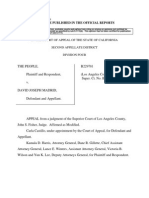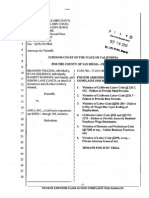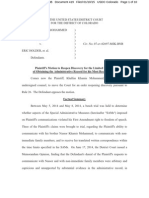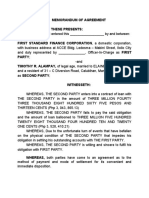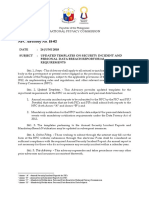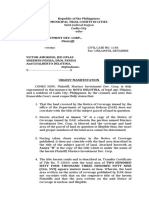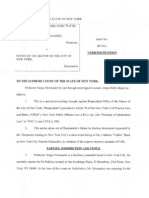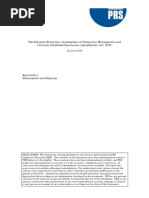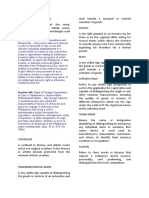Appellant's Reply Brief (City)
Appellant's Reply Brief (City)
Uploaded by
Sergio HernandezCopyright:
Available Formats
Appellant's Reply Brief (City)
Appellant's Reply Brief (City)
Uploaded by
Sergio HernandezCopyright
Available Formats
Share this document
Did you find this document useful?
Is this content inappropriate?
Copyright:
Available Formats
Appellant's Reply Brief (City)
Appellant's Reply Brief (City)
Uploaded by
Sergio HernandezCopyright:
Available Formats
Supreme Court, New York County Index No.
106213/2011
To be argued by SUSAN PAULSON
NEW YORK SUPREME COURT APPELLATE DIVISION: FIRST DEPARTMENT SERGIO HERNANDEZ, Petitioner-Respondent, For a Judgment Under Article 78 of the Civil Practice Law and Rules, -againstOFFICE OF THE MAYOR OF THE CITY OF NEW YORK, Respondent-Appellant. REPLY BRIEF OF APPELLANT MICHAEL A. CARDOZO, Corporation Counsel of the City of New York, Attorney for RespondentAppellant, 100 Church Street, New York, New York 10007. (212) 788-1362 or 1055 spaulson@law.nyc.gov FRANCIS F. CAPUTO, JEFFREY S. DANTOWITZ, SUSAN PAULSON, Of Counsel August 24, 2012
REPRODUCED ON RECYCLED PAPER
Page TABLE OF CONTENTS TABLE OF AUTHORITIES.......................................... ii PRELIMINARY STATEMENT.......................................... 1 ARGUMENT....................................................... 1 POINT I PETITIONER MISREADS THE COURT OF APPEALS DECISION IN TOWN OF WATERFORD........................................1 A. The Court of Appeals Decision in Town of Waterford Does Not Foreclose the Citys Arguments in this Case................................. 1 B. In Town of Waterford, the Court of Appeals Recognizes That FOIL Seeks To Protect Deliberative Processes.................................... 4 C. In Town of Waterford, the Court of Appeals Recognizes That Communications With Consultants Can Fall Within the IntraAgency Exemption............................. 7 POINT II AN AWARD OF ATTORNEYS FEES WOULD NOT BE PROPER IN THIS CASE......................10 CONCLUSION.................................................... 13 PRINTING SPECIFICATIONS STATEMENT............................. 14
Page TABLE OF AUTHORITIES CASES Fils-Aime v. Ryder TRS, Inc., 40 A.D.3d 917 (2d Dept. 2007) ............................... 9 Friedland v. Maloney, 148 A.D.2d 814 (3d Dept. 1989) ............................. 10 Harris v. City University of New York, Baruch College, 114 A.D.2d 805 (1st Dept. 1985) ............................ 12 Matter of Town of Waterford v. New York State Dept. of Envtl. Conservation, 18 N.Y.3d 652 (2012) ...................... passim One Beekman Place v. City of New York, Inc., 169 A.D.2d 492 (1st Dept. 1991) .......................... 6, 7 Sea Crest Constr. Corp. v. Stubing, 82 A.D.2d 546 (2d Dept. 1981) ............................... 9 Xerox Corp. v. Webster, 65 N.Y.2d 131 (1985) ................................. 3, 5, 11 STATUTES Education Law 2590-h........................................ 10 Education Law 3003(3)........................................ 9 Public Officers Law 86(3).................................... 3 Public Officers Law 87(2)(b)................................ 11 Public Officer Law 87(2)(g).................................. 6 Public Officers Law 89(4)(c)................................ 10
ii
PRELIMINARY STATEMENT By Order of the Supreme Court, New York County
(Schlesinger, J.), entered December 6, 2011, the Supreme Court granted petitioner-respondent Sergio Hernandezs Article 78
petition and directed the City to release certain documents he had requested from the Office of the Mayor of the City of New York (hereinafter the City) pursuant to the New York State Freedom of Information concluded Law (FOIL). the requested The Supreme are Court not
erroneously
that
documents
exempt from disclosure as intra-agency records. the decision of the Supreme Court should be reversed. Because addressed instant points. ARGUMENT POINT I PETITIONER MISREADS APPEALS DECISION WATERFORD. A. THE IN COURT TOWN OF OF the the appellants of the main brief
Accordingly,
anticipated arguments, arguments
and the and
majority addresses
petitioners certain
reply
only
briefly
The Court of Appeals Decision in Town of Waterford Does Not Foreclose the Citys Arguments in this Case. Petitioner argues that the recent decision of the
Court of Appeals in Matter of Town of Waterford v. New York State Dept. of Envtl. Conservation, 18 N.Y.3d 652, 658 (2012),
forecloses
the
Citys at
arguments 13-31.
on By
appeal. conflating
Brief the
for
Petitioner-Respondent
inter-
agency and intra-agency components of the FOIL exemption at issue in this case and misreading the argues decision that in Town Court the of of
Waterford, Appeals
petitioner
erroneously the
the
squarely
rejected
identical
arguments
City
raises here in that case.
Id. at 13.
The Citys arguments are
not, however, identical to those presented in Town of Waterford, and, to the extent that they under overlap, the facts such of arguments that case, were not
considered
and
evaluated
rejected as a matter of law. In Town of Waterford, the Court of Appeals held that the inter-agency exemption did not apply in that case because the United States Environmental Protection Agency (EPA) is not an agency as defined in the Public Officers Law. Waterford, 18 N.Y.3d at 657. Town of
The City does not, however, argue
either that the inter-agency exemption applies or that Ms. Black should be considered an agency for purposes of FOIL. Nor does the City argue that Courts have adopted a functional approach to the definition of agency. that Courts have adopted a The Citys argument is approach to the
functional
application of the intra-agency exemption, an argument that Town of Waterford recognizes to be valid, notwithstanding its
-2-
conclusion that the intra-agency exemption is inapplicable under the facts of that case. Id. at 657-658.
Although the Court of Appeals rejected the argument that the definition of agency in Public Officers Law 86(3) should not be applied to the distinct phrases inter-agency and intra-agency, it did recognize that documents prepared by a party that is not an agency can be withheld under the intraagency exemption. Id. at 657-658, citing Xerox Corp. v.
Webster, 65 N.Y.2d 131, 133 (1985) (records may be considered "intra-agency material" even though prepared by an outside
consultant at the behest of an agency as part of the agency's deliberative process). Thus, in Town of Waterford, the Court of
Appeals considered, and rejected, the argument that the EPA is the equivalent of an outside consultant, not as a matter of law, but under the facts of the case. Id. at 658.
Here, the City argues, not that Ms. Black comes within the definition of an agency and that the inter-agency
exemption should apply (see Brief for Petitioner-Respondent at 27-30, suggesting the contrary), wherein but the rather that this case
presents
circumstances
intra-agency
exemption
applies to a party that is not an agency, a party that acts in a manner akin to that of an agent or consultant. This argument is
plainly not foreclosed by the decision of the Court of Appeals in Town of Waterford.
-3-
B.
In Town of Waterford, the Court of Appeals Recognizes That FOIL Seeks To Protect Deliberative Processes. The City argues that this case presents circumstances
wherein the intra-agency exemption applies to a party that is not an agency because the records at issue reflect the predecisional deliberative process of government. Petitioner
construes this as a policy argument in favor of extending the intra-agency exemption; contends that, as such, Town of
Waterford, makes clear that this argument is irrelevant, as a matter of law; and argues that, to the extent that it is a recognized application policy to underlying the with exemption, individuals it has no a
communications
outside
government agency. Petitioner further
Brief for Petitioner-Respondent at 19-20. argues that the responsive documents are
neither pre-decisional nor deliberative. is no merit to these claims.
Id. at 30-31.
There
As an initial matter, protecting the candor of those assisting in the decision-making process is not a policy
argument in favor of creating a new exemption from the Freedom of Information Law. As the Court of Appeals acknowledge in Town
of Waterford, it is a recognized rationale for the intra-agency exemption at issue in this case. See Town of Waterford, 18
N.Y.3d at 658 (We have held that the purpose of the intraagency exception is to allow individuals within an agency to
-4-
exchange process, public.).
their without
views the
freely, concern
as that
part
of
the ideas
deliberative will become
those
Nor,
as
petitioner
argues,
is
this
rationale
inapplicable simply because the communications at issue are with an individual outside of government. Brief for Petitioner-
Respondent at 20.
In Town of Waterford, the Court of Appeals
also recognized that in Xerox Corporation, it had determined that real estate firm at appraisal the reports prepared by a private from
consulting
agency's
request
were
exempt
disclosure as intra-agency material, observing that "[i]t would make little sense to protect the deliberative process when such reports are prepared by agency employees yet deny this
protection when reports are prepared for the same purpose by outside consultants retained by agencies". Town of Waterford,
18 N.Y.3d at 658, citing Xerox Corporation, 65 N.Y.2d at 133. Here, Ms. Black, City staff and/or Hearst Corporation staff assigned to assist Ms. Black in her transition to City government, about the were communicating of the with Citys each other to though email
preparation
request
Commissioner
Steiner for a School District Leader Certificate for Ms. Black, responses community. to routine queries, and outreach planning to the
R. 44.
These emails included discussions concerning
clarification of Ms. Blacks background, discussions related to
-5-
contacts
with
various
individuals
regarding
Ms.
Blacks
selection, and drafts of the letter to be sent to Commissioner Steiner. See id. These communications prepared of to are assist the smooth pre-decisional the City in
deliberative carrying Leader out
communications, its function to
obtaining the
School
District of
Certificate
facilitate
transition
government. the State
The City does not argue that the emails relate to Education Departments deliberative process in
deciding whether to grant Ms. Black the waiver request. 15.
See R.
The emails relate to the Citys deliberative process in R. 44. They are pre-decisional
preparing the waiver request.
with respect to the Citys waiver request, not with respect to the States decision in response to the request. As such, they
are exempt from disclosure under Public Officer Law 87(2)(g). Finally, petitioner mistakenly argues that One Beekman Place v. City of New York, Inc., 169 A.D.2d 492 (1st Dept. 1991), is inapposite because it concerns a motion to compel documents withheld in discovery, not a FOIL request. for Petitioner-Respondent at 20 n4. In One See Brief Place,
Beekman
however, this Court explicitly recognized that the Freedom of Information discovery, Law, like the public from are interest privilege inter-agency policy in or or and
similarly
exempts that to
disclosure not final
intra-agency
materials in
agency
determinations
order
encourage
candid
discussion
-6-
representation of views among government employees involved in the development of policy. 493. One Beekman Place, 169 A.D.2d at
Thus, One Beekman Place is indeed relevant to the Citys
argument that the subject documents can be withheld under the intra-agency exemption to protect the deliberative process of government. C. In Town of Waterford, the Court of Appeals Recognizes That Communications With Consultants Can Fall Within the IntraAgency Exemption. Petitioner contends that the Citys argument that Ms. Blacks role was akin to that of a consultant is foreclosed by Town of Waterford and that Ms. Black was not a consultant as a matter of law. Brief for Petitioner-Respondent at 21.
Recognizing, however, that the Courts have articulated a factbased analysis to determine if the consultant corollary to the intra-agency exemption applies, petitioner also argues that Ms. Black did not act as a consultant because she was not retained as such by or in the City, did and not fulfill the her function own Id. of a
consultant interests
employee, the
represented
independent at 23-26. Town of factors
subject
communications.
Plainly, the Citys argument is not foreclosed by Waterford, and requires consideration of all of the
relevant to the analysis. In argument that Town the of EPA Waterford, is the in analyzing of respondents an outside
equivalent
-7-
consultant, the Court of Appeals considered a number of factors without identifying any single one of them as dispositive. of Waterford, 18 N.Y.3d at 658. Town
The Court of Appeals considered
the fact that: the Environmental Protection Agency (EPA) and Department of Environmental Conservation (DEC) have a
collaborative relationship and are presumably working together toward the same goal; that the EPA was not retained by the DEC and does not function as its employee or agent; that the EPA is the lead agency for the project at issue; and that the EPA and the DEC represent different constituencies and have interests that may diverge. Town of Waterford, 18 N.Y.3d at 658. Upon
consideration of these factors, the Court of Appeals concluded that the EPA is not the equivalent of an outside consultant under the facts of that case. Id.
Here, petitioner argues that because Ms. Black was not retained by the City and because, in petitioners view, she was acting in her own self-interest, the consultant corollary cannot apply. Brief for Petitioner-Respondent at 23-27. Unlike the
EPA in Town of Waterford, though, which functioned as the lead agency, not as an employee or agent, under the instant
circumstances Ms. Black was communicating with the City at the Citys behest assisting the City in performing its own function of obtaining the Certificate from the State. And unlike the EPA
in Town of Waterford, Ms. Black did not represent a different
-8-
constituency than the Mayors Office or have any interests that may diverge with regard to the request for a School District Leader Certificate from the State. Ms. Black was communicating with the Mayors Office not in her own self interest, but rather in furtherance of the Mayors District interest Leader The that she be awarded so that her the she for requested could School as the
Certificate Mayor
serve to
Chancellor.
selected
appointment
position of Chancellor and, pursuant to Education Law 3003(3), the Mayor was required to submit the Certificate request to the State. Ms. Black and Hearst Corporation employees were
assisting the Mayors office in performing the function assigned to the Mayor by law, requesting a School District Leader
Certificate for a candidate that he had selected to appoint as Chancellor. In evaluating Ms. Blacks actual function in the
communications at issue in this case, this Court should conclude the consultant corollary properly applies. 1 See Sea Crest
These same facts support the Citys argument that Ms. Black was acting in a manner akin to an agent of the City during the relevant time period. Having been selected by the Mayor as the incoming Chancellor and having accepted that selection, to facilitate this transition, Ms. Black acted under the Citys guidance in furtherance of its interest in having that selection approved through Commissioner Steiners issuance of the requested certificate. See Fils-Aime v. Ryder TRS, Inc., 40 A.D.3d 917, 918 (2d Dept. 2007) (principal-agent relationship may be established by evidence of consent of one person to allow another to act on his or her behalf and subject to his or her control, and consent by other so to act, even where agent is -9-
Constr. Corp. v. Stubing, 82 A.D.2d 546, 549 (2d Dept. 1981) (actual function served by outside party must be considered in deciding whether communications are encompassed by intra-agency exemption, designation as "consultant" is not determinative). POINT II AN AWARD OF ATTORNEYS FEES WOULD NOT BE PROPER IN THIS CASE Under Public Officers Law 89(4)(c), the Court may assess against an agency reasonable attorneys fees and other litigation costs reasonably incurred to a party who has
substantially prevailed in a FOIL action when the agency had no reasonable basis for denying access to the requested materials. An award under this section is within the sound discretion of the trial court. (3d Dept. 1989). See Friedland v. Maloney, 148 A.D.2d 814, 815 If, however, this Court decides to address the
issue of attorneys fees in the first instance, there is no basis to conclude that an award of fees and costs would be appropriate under the facts of this case. As explained above
and in appellants main brief, where courts have held that, in some situations, documents prepared by a party that is not an agency can be withheld under the intra-agency exemption, the acting as volunteer). Ms. Black was selected for appointment to a position in which she would serve at the pleasure of the Mayor and as a candidate for such a position would be subject to the Mayors direction and control. See Education Law 2590-h
-10-
City had a reasonable basis for denying access to the requested materials as exempt under Public Officers Law 87(2)(g). Town of Waterford, 18 N.Y.3d at 657-658, citing See Xerox
Corporation, 65 N.Y.2d at 133 (records may be considered "intraagency material" even though prepared by an outside consultant at the behest of an agency as part of the agency's deliberative process). Under the facts of this case, the Citys invocation of intra-agency exemption to protect the email communications
between Ms. Black and the City was not patently unreasonable. The City had a reasonable basis for invoking the intra-agency exemption and, as explained above, the fact that Ms. Black is not an agency, a fact that City does not dispute, is not dispositive of this issue. In addition, there is a sound
factual basis for the application of the consultant corollary in this case and the decision of the Court of Appeals in Town of Waterford underscores the reasonableness, not, as petitioner
argues, the frivolity of this argument, by articulating the factors to be considered in determining if the consultant
corollary applies.
Town of Waterford, 18 N.Y.3d at 658.
Finally, the City neither conceded that the privacy exemption articulated in Public Officers Law 87(2)(b) does not (Chancellor shall serve at pleasure of Mayor of City of New York).
-11-
apply nor abandoned the argument in the Supreme Court.
The City
argued that the privacy exemption applied to the private cell phone numbers and and other email addresses that of certain government in the
officials
stakeholders
were
contained
documents, a point that petitioner did not dispute. 46.
See R. 13,
Petitioners agreement to the redaction of this private
information confirms that the City had a reasonable basis for the assertion of the exemption to protect the privacy of
personal cell phone numbers and email addresses.
See Harris v.
City University of New York, Baruch College, 114 A.D.2d 805 (1st Dept. 1985) (directing disclosure of records subject to deletion of names, addresses and Social Security numbers protected by privacy exemption without award of costs). Where the City had a reasonable basis for denying
access to the responsive documents, there is no basis for an award of attorneys fees in this case.
-12-
CONCLUSION THE ORDER OF THE SUPREME COURT SHOULD BE REVERSED AND THE PETITION SHOULD BE DISMISSED. Respectfully Submitted, MICHAEL A. CARDOZO Corporation Counsel, Attorney for Respondent-Appellant. By: SUSAN PAULSON FRANCIS F. CAPUTO, JEFFREY S. DANTOWITZ, SUSAN PAULSON, Of Counsel.
-13-
PRINTING SPECIFICATIONS STATEMENT This using Courier brief New was 12. prepared with to Microsoft the Word 2003,
According
aforementioned
processing system, the entire brief, including portions that may be excluded from the word count pursuant to 22 N.Y.C.R.R.
600.10(d)(1)(i), contains 3,063 words. Dated: New York, New York August 24, 2012 MICHAEL A. CARDOZO Corporation Counsel of the City of New York Respondent-Appellant By: Susan Paulson Assistant Corporation Counsel 100 Church Street New York, New York 10007
-14-
You might also like
- Contract Comodat Ro-En 13.03.2015Document3 pagesContract Comodat Ro-En 13.03.2015hertatradNo ratings yet
- State Motion To Quash SubpoenaDocument2 pagesState Motion To Quash SubpoenaChad PetriNo ratings yet
- Notice of Motion To Dismiss Appeal (Hernandez)Document47 pagesNotice of Motion To Dismiss Appeal (Hernandez)Sergio HernandezNo ratings yet
- Secs Cert ElviraDocument2 pagesSecs Cert ElviraAnn SCNo ratings yet
- Darlene Jenkins Vs McDonald'sDocument6 pagesDarlene Jenkins Vs McDonald'sEater50% (2)
- KMM v. Cargill - Reply 080417Document27 pagesKMM v. Cargill - Reply 080417marizamoraNo ratings yet
- Final OrderDocument15 pagesFinal OrderMartin Austermuhle100% (2)
- War crimes and crimes against humanity in the Rome Statute of the International Criminal CourtFrom EverandWar crimes and crimes against humanity in the Rome Statute of the International Criminal CourtNo ratings yet
- Notice of Motion For Leave To Appeal To The Court of AppealsDocument15 pagesNotice of Motion For Leave To Appeal To The Court of AppealsSergio HernandezNo ratings yet
- Sample Judicial AffidavitDocument5 pagesSample Judicial AffidavitPaoloTrinidadNo ratings yet
- Feeder International Line Ltd. Vs CA DigestDocument1 pageFeeder International Line Ltd. Vs CA DigestAlthea M. SuerteNo ratings yet
- Appellant's Reply BriefDocument40 pagesAppellant's Reply BriefSensa VerognaNo ratings yet
- First Discovery Request in Brown-Dickerson v. City of Philadelphia, Et AlDocument6 pagesFirst Discovery Request in Brown-Dickerson v. City of Philadelphia, Et AlThe DeclarationNo ratings yet
- Alias SummonsDocument2 pagesAlias SummonsCarlaNo ratings yet
- Motion To CancelDocument11 pagesMotion To CancelBillSchmalfeldt100% (1)
- TxDOT Response To InjunctionDocument13 pagesTxDOT Response To InjunctionCBS Austin WebteamNo ratings yet
- Property Ownership CasesDocument199 pagesProperty Ownership CasesWarly PabloNo ratings yet
- Case No. 4:13-CV-05428-DMR Answer, Counterclaims, and Demand For Jury TrialDocument20 pagesCase No. 4:13-CV-05428-DMR Answer, Counterclaims, and Demand For Jury TrialEriq GardnerNo ratings yet
- Sample Response To Demand For Physical Examination in CaliforniaDocument3 pagesSample Response To Demand For Physical Examination in CaliforniaStan Burman100% (1)
- Non CompeteDocument10 pagesNon CompeteAlyssa Clarizze MalaluanNo ratings yet
- Acknowledgment of OwnershipDocument1 pageAcknowledgment of OwnershipJam RockyouonNo ratings yet
- Arizona MaravillaDocument40 pagesArizona MaravillaArizona MaravillaNo ratings yet
- Apple California Labor Code Class Action Suit - Amended Complaint 4Document23 pagesApple California Labor Code Class Action Suit - Amended Complaint 4Mikey CampbellNo ratings yet
- Craig Wright's Notice of ComplianceDocument2 pagesCraig Wright's Notice of ComplianceForkLogNo ratings yet
- Lopez V. Pan American World AirwaysDocument17 pagesLopez V. Pan American World AirwaysMikee Baliguat TanNo ratings yet
- Order Dismissing CaseDocument3 pagesOrder Dismissing CaseyogaloyNo ratings yet
- Marie Callo-Claridad vs. Philip Ronald P. Esteban and Teodora Alyn Esteban, G.R. No. 191567, March 20, 2013Document6 pagesMarie Callo-Claridad vs. Philip Ronald P. Esteban and Teodora Alyn Esteban, G.R. No. 191567, March 20, 2013MarianoFloresNo ratings yet
- Alcantara ComplaintDocument6 pagesAlcantara ComplaintmisyeldvNo ratings yet
- Temple's Severance AgreementDocument5 pagesTemple's Severance AgreementgharmanNo ratings yet
- Sun Products v. Linares (Amended Complaint)Document38 pagesSun Products v. Linares (Amended Complaint)Ken VankoNo ratings yet
- Motion To DismissDocument3 pagesMotion To DismissChristopherJordanOrtizNo ratings yet
- G.R. No. 138197 (Fine Not Exceed 200k) PDFDocument4 pagesG.R. No. 138197 (Fine Not Exceed 200k) PDFFrancis Ray Arbon Filipinas100% (1)
- Plaridel-Surety-GR-183128-Mar-20-2017 Full TextDocument8 pagesPlaridel-Surety-GR-183128-Mar-20-2017 Full TextC SNo ratings yet
- Flextronics v. AliphCom Dba JawboneDocument8 pagesFlextronics v. AliphCom Dba JawboneAndrew NuscaNo ratings yet
- Motion To Defer Arraignment and Motion For Reinvestigatio - Google SearchDocument2 pagesMotion To Defer Arraignment and Motion For Reinvestigatio - Google SearchSarah Jane-Shae O. Semblante0% (2)
- Jurisprudence 2Document4 pagesJurisprudence 2KarlaAlexisAfableNo ratings yet
- Motion For RequestDocument6 pagesMotion For RequestAvelino Garchitorena Alfelor Jr.No ratings yet
- LLL'DSWD: Administrative Order No. Series 2017Document18 pagesLLL'DSWD: Administrative Order No. Series 2017SGT100% (1)
- Affidavit of Loss-TCT (Pundo)Document1 pageAffidavit of Loss-TCT (Pundo)serbisyo legalNo ratings yet
- Gamayon NoticeOfAppealDocument2 pagesGamayon NoticeOfAppealreese93No ratings yet
- Khalfan Khamis Mohammed Motion To Reopen DiscoveryDocument10 pagesKhalfan Khamis Mohammed Motion To Reopen DiscoveryPaulWolfNo ratings yet
- Fairfax Commonwealth's Attorney Procedure MemorandumDocument12 pagesFairfax Commonwealth's Attorney Procedure MemorandumDon Parker0% (1)
- Emergency Motion To Preserve EvidenceDocument18 pagesEmergency Motion To Preserve EvidenceJay WayneNo ratings yet
- Motion To Post BondDocument20 pagesMotion To Post BondJ Doe100% (1)
- Republic of The Philippines Municipal Trial Court First Judicial Region Branch 426-A Baguio CityDocument4 pagesRepublic of The Philippines Municipal Trial Court First Judicial Region Branch 426-A Baguio CityDeborah Micah PerezNo ratings yet
- Civil Compliant For Collection of Sum of Money-CattleyaDocument5 pagesCivil Compliant For Collection of Sum of Money-Cattleyalenardoes123456No ratings yet
- MOADocument5 pagesMOARhoan HiponiaNo ratings yet
- Provisional Work Permit (PWP)Document1 pageProvisional Work Permit (PWP)Enika GarciaNo ratings yet
- Position Paper-Complainant OJT ExamDocument7 pagesPosition Paper-Complainant OJT ExamKhristienne BernabeNo ratings yet
- Insurance Claim ComplaintDocument4 pagesInsurance Claim ComplaintCzarlyn NunezNo ratings yet
- Final Advisory18-02 6.26.18Document8 pagesFinal Advisory18-02 6.26.18mark john batingalNo ratings yet
- Disengagement LetterDocument1 pageDisengagement Letterapi-518705643No ratings yet
- Motion To Resolve SampleDocument4 pagesMotion To Resolve SampleJuan GeronimoNo ratings yet
- Judicial Affidavit of Kristhian Mark Maestral NBI 2Document3 pagesJudicial Affidavit of Kristhian Mark Maestral NBI 2Robert Faldas Catolico IINo ratings yet
- Motion To Disallow Deposition Feb16 A1104Document9 pagesMotion To Disallow Deposition Feb16 A1104RG CruzNo ratings yet
- Info Shoppee: Eye Hospital Road SITAPUR 261001 Party DetailsDocument1 pageInfo Shoppee: Eye Hospital Road SITAPUR 261001 Party DetailsGaurav JaiswalNo ratings yet
- In Re Right of InspectionDocument3 pagesIn Re Right of InspectionClarissa de VeraNo ratings yet
- Contracts DrillsDocument19 pagesContracts DrillsvionysusgoghNo ratings yet
- Sandiganbayan Bail RequirementsDocument1 pageSandiganbayan Bail RequirementsQuito NituraNo ratings yet
- A.M. No. 03-04-04-SCDocument5 pagesA.M. No. 03-04-04-SCGodofredo SabadoNo ratings yet
- Davao Light and Power Co p6Document2 pagesDavao Light and Power Co p6Tet DomingoNo ratings yet
- LOA-with Waiver&assumption - Of.riskDocument1 pageLOA-with Waiver&assumption - Of.riskDoni Richard SalazarNo ratings yet
- Urgent Manifestation - Marisco Vs AmorosoDocument2 pagesUrgent Manifestation - Marisco Vs AmorosoJoann LedesmaNo ratings yet
- Going Public: My Adventures Inside the SEC and How to Prevent the Next Devastating CrisisFrom EverandGoing Public: My Adventures Inside the SEC and How to Prevent the Next Devastating CrisisRating: 5 out of 5 stars5/5 (1)
- Walking a Tightrope: Biography of Honorable Mayor Catalino Gabot Hermosilla Sr.From EverandWalking a Tightrope: Biography of Honorable Mayor Catalino Gabot Hermosilla Sr.No ratings yet
- Memorandum of Law in Support of Motion To Dismiss (Hernandez)Document16 pagesMemorandum of Law in Support of Motion To Dismiss (Hernandez)Sergio HernandezNo ratings yet
- Affirmation in Opposition To Motion To Dismiss (City)Document5 pagesAffirmation in Opposition To Motion To Dismiss (City)Sergio HernandezNo ratings yet
- FOIL RequestDocument2 pagesFOIL RequestSergio HernandezNo ratings yet
- Memorandum of Law in Support of AnswerDocument24 pagesMemorandum of Law in Support of AnswerSergio HernandezNo ratings yet
- Index 10621312011 Hernandez, Sergio Office of The Mayor: NumberDocument12 pagesIndex 10621312011 Hernandez, Sergio Office of The Mayor: NumberSergio HernandezNo ratings yet
- CB EmailsDocument78 pagesCB EmailsCeleste KatzNo ratings yet
- Affirmation in Opposition To Motion For Leave To Appeal To NYS Court of AppealsDocument13 pagesAffirmation in Opposition To Motion For Leave To Appeal To NYS Court of AppealsSergio HernandezNo ratings yet
- Grassley NYU LetterDocument4 pagesGrassley NYU Letternicholasjpinto100% (1)
- Article 78 PetitionDocument18 pagesArticle 78 PetitionSergio HernandezNo ratings yet
- City's Affirmation in Support of Motion For Leave To Appeal To NYS Court of AppealsDocument19 pagesCity's Affirmation in Support of Motion For Leave To Appeal To NYS Court of AppealsSergio HernandezNo ratings yet
- Affirmation in Opposition of Motion For Leave To AppealDocument8 pagesAffirmation in Opposition of Motion For Leave To AppealSergio HernandezNo ratings yet
- Sergio Hernandez: ExperienceDocument2 pagesSergio Hernandez: ExperienceSergio HernandezNo ratings yet
- Order To Bloomberg Administration To Turn Over Cathie Black EmailsDocument3 pagesOrder To Bloomberg Administration To Turn Over Cathie Black EmailsChristopher RobbinsNo ratings yet
- NYC City Council Int. No. 0227-2010Document2 pagesNYC City Council Int. No. 0227-2010Sergio HernandezNo ratings yet
- Judicial Conduct Case - OCA Vs BalutDocument3 pagesJudicial Conduct Case - OCA Vs BalutJane SudarioNo ratings yet
- c2 Cases 3Document166 pagesc2 Cases 3Myooz MyoozNo ratings yet
- Helsinki Committee For Human Rights of The Republic of MacedoniaDocument282 pagesHelsinki Committee For Human Rights of The Republic of MacedoniaLjuben Dimanovski100% (2)
- Republic vs. EbradaDocument4 pagesRepublic vs. Ebradamia_2109No ratings yet
- Cyber CrimeDocument30 pagesCyber Crimesimbu500% (1)
- Hurt - Grievous HurtDocument5 pagesHurt - Grievous Hurtyash100% (1)
- V-7 G.R. No. 150611 Saguid Vs CADocument7 pagesV-7 G.R. No. 150611 Saguid Vs CAIter MercatabantNo ratings yet
- Ethics Chapter 9Document9 pagesEthics Chapter 9RheaNo ratings yet
- G.R. No. 173773 November 28, 2012 Paramount Insurance Corporation, Petitioner, Spouses Yves and Maria Teresa Remondeulaz, RespondentsDocument4 pagesG.R. No. 173773 November 28, 2012 Paramount Insurance Corporation, Petitioner, Spouses Yves and Maria Teresa Remondeulaz, RespondentsJoy Carmen CastilloNo ratings yet
- Batangas Laguna Tayabas Bus Vs CADocument6 pagesBatangas Laguna Tayabas Bus Vs CAruss8dikoNo ratings yet
- Chapter 1 Risk Management and Sources of Law - PDF FormatDocument40 pagesChapter 1 Risk Management and Sources of Law - PDF FormatarekiehNo ratings yet
- LvivDocument22 pagesLvivAsad Ali KhanNo ratings yet
- AG V Birmingham Schools: Motion For Temporary Restraining Order and Preliminary InjunctionDocument10 pagesAG V Birmingham Schools: Motion For Temporary Restraining Order and Preliminary InjunctionWeld for BirminghamNo ratings yet
- Criminal Vehicular HomicideDocument5 pagesCriminal Vehicular HomicidePatch MinnesotaNo ratings yet
- M.R. Balaji SummaryDocument3 pagesM.R. Balaji Summaryabhinay06No ratings yet
- Fcra Act 1976 PDFDocument2 pagesFcra Act 1976 PDFShawnNo ratings yet
- Republic v. Munoz - Digest.doc JomDocument3 pagesRepublic v. Munoz - Digest.doc JomjomgonziNo ratings yet
- Introduction To The American Legal System - LexisNexisDocument5 pagesIntroduction To The American Legal System - LexisNexisvovkjessNo ratings yet
- Bridging The GapDocument11 pagesBridging The GapMichelle FelloneNo ratings yet
- Boroc Cbydp ResolutionDocument2 pagesBoroc Cbydp ResolutionMina Atienza Paña86% (7)
- Republic v. LimDocument1 pageRepublic v. LimAdrian Jeremiah VargasNo ratings yet
- Draft Motion For ReconsiderationDocument4 pagesDraft Motion For ReconsiderationRam Eman OsorioNo ratings yet
- Cabalan (CAPANELA) vs. NLRC and SanchezDocument1 pageCabalan (CAPANELA) vs. NLRC and SanchezColmenares TroyNo ratings yet
- The Sthanam Properties (Assumption of Temporary Management and Control) and Hindu Succession (Amendment) Act, 1958Document10 pagesThe Sthanam Properties (Assumption of Temporary Management and Control) and Hindu Succession (Amendment) Act, 1958Shubham PandeyNo ratings yet
- Carriage by Road ActDocument22 pagesCarriage by Road ActPRADEEP MK100% (1)
- Section 3. International Conventions And: Reciprocity. - Any Person Who Is A NationalDocument1 pageSection 3. International Conventions And: Reciprocity. - Any Person Who Is A NationalCharise MacalinaoNo ratings yet
- Villanueva vs. RosquetaDocument2 pagesVillanueva vs. RosquetaMei SuyatNo ratings yet





















